Canine Bloat Diary
Thank God I Wrote That Article
About a year or so ago, I was asked to write some canine health articles for this website. I gladly agreed and proceeded to ask my Shiloh Shepherd breeder for some suggestions of health issues of a serious nature. I wanted to report on something life-threatening so that someday perhaps the information I gathered could save a dog’s life because their owner read my article. How ironic to discover that the owner I saved from having to deal with the death of a pet was me.
After a long day of outdoor summer fun at my sister’s house, my family returned home late, about 9:30 p.m., to find all three of our dogs safe and sound, but very hungry, having missed their normal 6:00 p.m. dinner. We were exhausted after the hour-and-a-half car ride home and still had to put the kids to bed, so we fed the dogs then let them outside to relieve themselves quickly, so we could go to bed. My husband and I fell asleep while waiting for them and about an hour later I was startled awake by a loud bark. Still half asleep, I went downstairs and let the dogs in. I put two of them in their crates with locked gates, and my Shiloh Shepherd, Meadow in her crate, but with the gate unlocked. It was a last-minute decision to let her wander free should she decide to, since she was my mature, well-trained 5 1/2 year old and I felt guilty having left her home inside for so long without us. I returned upstairs to bed and immediately fell back asleep.
No more than 15 minutes later, I was reawakened by the sound of Meadow “throwing up” in the downstairs great room. I went downstairs and braced myself for a gross mess but was surprised to find nothing anywhere. “You OK, girl?” I asked with concern, patted her head then returned upstairs. Five minutes later I heard the same retching sound along with some whimpering. I rushed downstairs to see Meadow just about to vomit so I ran to her and opened the sliding doors while ushering her outside just in time to vomit on the grass. But again when I looked where she vomited, there was nothing. She disappeared in the darkness of our two-acre fenced-in dog yard. I had to get a flashlight to find her. When I did, I saw she had hunkered down in the corner of the fence. She was lying down now, on her stomach and elbows and hind quarters, panting faster than I ever heard any dog; short, shallow, fast panting. She clearly was in distress. I called to her but she didn’t budge. So I went out to get her, took her by the collar and brought her inside for a better look. It was then I noticed her sides were bulging out. They were blown-up like balloons and tight as footballs to the touch. I put the three or so symptoms together and knew for sure Meadow had what is called BLOAT.
The scientific term is “gastric dilatation.” This is when the stomach is stretched by gas and/or food to much bigger than normal size. Then for some reason, still unknown, it twists and blocks off its own blood supply along with the exit routes of the gas and food that’s in it. The twisting is called “volvulus.” The bloating is extremely painful, but when there is bloating WITH volvulus/twisting, it is life-threatening. There is no way to know if the bloating has occurred with the twisting until the abdomen is x-rayed. Either way, the symptoms are to be treated as an EMERGENCY and the dog needs to be RUSHED to the hospital IMMEDIATELY.
Thankfully, I remembered the symptoms from the article I wrote. I quickly led her into the van, ran upstairs to tell my husband, and rushed her to the animal emergency hospital. En route I checked my wallet and luckily I had slipped the hospital’s card in it months prior. All pet owners should do this. I called there to tell them I was on my way which was good because they were waiting for me when I arrived. In the case of bloat, every minute counts. On the ride there, Meadow could not find a comfortable position to sit still or lie. She changed her place and position the entire ride over. This is another symptom resulting from the intense pain.
When I arrived, the staff took one look at her bloated midsection and they were pretty sure it was bloat even before she was diagnosed. They asked me to describe her other symptoms. I told them about her:
- attempts to vomit to no avail
- whining
- hiding and not coming when called (any sort of strange behavior)
- failed attempts to get comfortable.
The veterinarian entered then and told me he would have her stomach x-rayed to determine for sure that it was bloat. If it was, the films would show the twisted stomach which literally turned around. When this happens “necrosis” begins, due to the lack of blood supply and oxygen to the stomach. Necrosis is cell death. Once dead, there is no fixing it. This is the main reason why time is so important in the case of bloat. With each minute that passes more permanent damage can be done.
After the x-ray, the vet ordered another test to determine the degree of necrosis. He called it a CG4/lactate, or lactate test. This is when he told me that a normal lactate number is 2. When dealing with bloat, a lactate score between 3 and 6 is considered good, or operable. He told me if she were above 6, too much damage would have been caused by the restriction and he would not operate. Instead, he would have to PUT HER TO SLEEP. Meadow’s score was 4.8. I got her there in time to survive, but still, some damage was done with a 4.8 score. The necrotic area would have to be removed with a partial gastrectomy. Thank God I wrote the bloat article and knew what was happening to her. Had I not, I very well may have simply let her outside to be sick and then maybe take her to the vet in the morning. I never would have seen the panting to begin with and most likely may have gone back to sleep. If this were the case, the vet told me she would have been dead within four hours.
While he talked to me, the staff shaved some fur off her legs and put tube lines in for IV fluids and nice dose of hydromorphone to keep her hydrated and better able to tolerate the severe pain she was currently feeling.
The surgery took about 1.5 hours. I waited in the waiting room for my very confident vet to finish. He told me he had done hundreds of these procedures and that not once did the twisting reoccur. The reason is because not only does the doctor empty the stomach of the gas and untwist it, he also “permanently adheres” the stomach to the peritoneum wall. This prevents the stomach from twisting (volvulus) ever again. There is a very slight chance something could go wrong and it may retwist again in the future, but my vet hadn’t had that ever happen thus far. That bit of information made me thankful he was the doctor performing the surgery. When it was over he came out, assured me she did great, was doing fine and that I could go home and call him before he leaves at 7:30 a.m. for an update. Also, this is when I learned that the spleen is often removed due to damage too, but Meadow’s was still fine and could be left alone.
Tuesday morning:
When I called, she was still doing well. The best thing about her recovery post-op was that she was having normal heart rhythms. Apparently this is the biggest concern post-op with this procedure. I’m not sure why exactly, but was just thankful she was doing well.
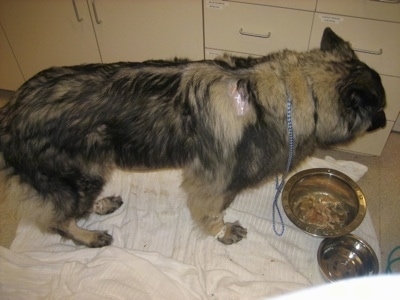
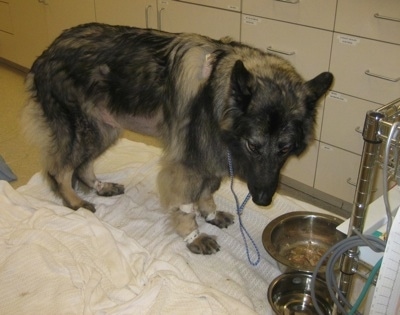
Tuesday early evening:
I was told I could visit Meadow at the hospital but that she would need to stay another night . She wasn’t eating for them so I suggested that I bring something I knew she loved to try and get something down. I brought fresh cooked cut up chicken breast left from our dinner the night before. She didn’t eat a bite of it. No appetite yet. She barely looked at me and I felt as though she were someone else’s dog. I was just so glad to see her, see her doing well, and realized just how much I love that girl of mine. I missed her so much.
Wednesday:
Meadow came home. She has gotten up by her own will various times today. She didn’t need me to force her to get up and walk so she could relieve herself outside, or eat and drink. She has eaten the food the hospital prescribed for me to give her. After surgery of the stomach like hers, a special diet is required. They gave me a case of Hill’s Science Diet ID for her to eat during recovery. This food is used for sensitive digestion and cases of surgical stomach recovery like Meadow’s.
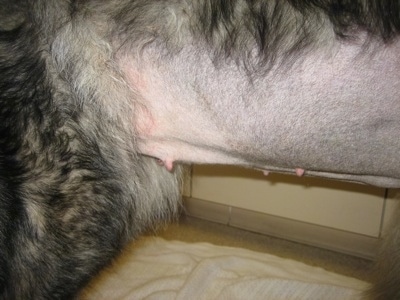
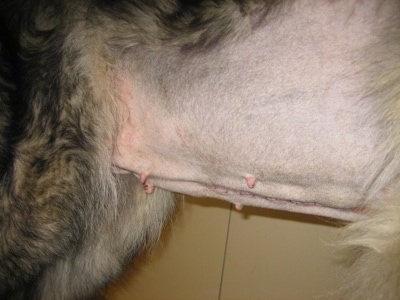
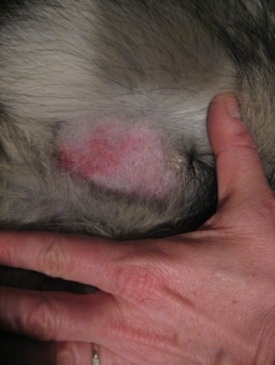
Thursday:
Meadow will not eat today. At least she is getting the morphine patch taken off today. They had shaved an area on the side of her trunk and placed the clear, plastic, narcotic -filled patch there. When she returned to the waiting room after they ripped it off, I looked at it and the skin at the site was very red and swollen. As the day progressed it got worse looking. Hopefully tomorrow I’ll see some change.
The worst thing about today though, is the fact that I spotted her licking at her sutures feverishly. It’s the first time she’s attempted this since the surgery. I’m glad I wrote myself a note to ask the staff at the hospital if she will need an E-collar, or lampshade as I like to call it. They were ready to send her home without one. They asked if she was chewing on them, and I said not yet, but she may as they begin to heal and cause itching. They said it was my choice and gave me one to take home. Because she wouldn’t stop licking at them, I was forced to put the collar on her. This act was almost as sad as the day I took her into the ER for the surgery. I hope she gets used to it soon; she sure is having a hard time with it now.
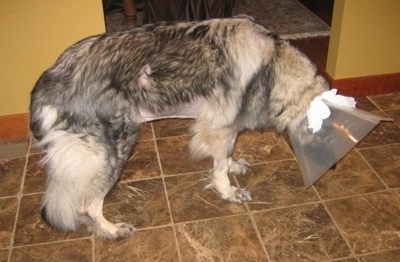
Friday, four days post-surgery:
I can’t take it anymore. I just took off the collar and am going to take my chances that she won’t chew her stitches. With the collar on, all she does is stand in a corner with her head drooped downward, very still and never changing position. She won’t eat, drink, sleep or even move. Last night, I left her downstairs and returned three hours later to find she was in the same exact spot and same position. I forced her upstairs and into a lying position, then I went to bed. This morning, when she still would not eat or drink, I chucked the collar. I just said a prayer and left her home while I had business to attend to. When I returned, the sutures were still nice and dry and untouched. She was relaxed enough now to eat, drink and lie down on her own for a long afternoon nap, which she desperately needed.
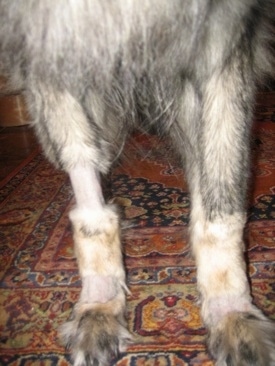
Saturday, five days post-surgery:
Today Meadow is the closest she’s been to her normal self since the whole episode. Until today, she had been acting like a totally different dog: shy, nervous, sleepy, lethargic, no personality at all. But now her typical personality is breaking through. She’s been eating and drinking great. And, finally, for the first time since the procedure, she pooped. The anesthesia and strong painkillers cause constipation due to the fact that they slow metabolism and intestinal movements (peristalsis).
I was still concerned about the stitches being toyed with, so I told my vet about taking the collar off and why. That’s when he told me there’s a product called Yuk that you can rub around the sutures, but not on them, and it will deter the dog from licking there. I was to put Neosporin directly on the incision and apply the Yuk all around the area. Well that was a big mistake. I should have left well enough alone. She had been staying away from the stitches, but since she had been licking them so much right before I put on the collar, I figured she’d do it more—it was just a matter of time. Well, she did lick again, right after I put on the Yuk! Guess it’s not that yucky after all; I mean, dogs eat their own poop half the time, how bad can this Yuk stuff be to them?
Monday, One week post-operation:
Over the weekend I noticed redness spreading around the incision area. I thought it was an infection beginning to worsen. This concerned me since I am giving her antibiotics, Cephelexin, twice a day and haven’t skipped once. If it was an infection, what could I give her now that would make a difference? I decided to bring her to my vet to have him take a look at it. It turns out to be just bruising, not infection. But he did notice that the incision has started to pucker. The skin between the staples has pulled apart, causing small gaps that have puckered. He said it‘s OK, but gave me some cream to rub on it 2-3 times a day. It’s called Derma Cleanse. Apparently “puckering” of the incision is common, especially on areas like the stomach region, since that’s where she lays and flops down onto.
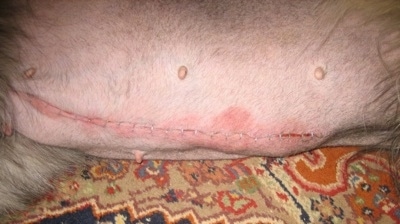
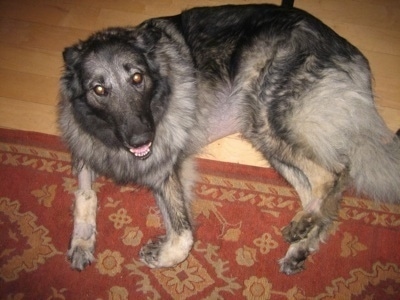
I learned a couple of other things today as well. I was informed that she is going to have her sutures removed on Friday, 11 days post-op. My regular vet is going to remove them, not the ER doctors. Also, I was glad to learn that I was able to take her on a “short” walk today. Meadow is used to daily walks of at least four miles since she is an avid Cesar Milan fan. I notice that my dogs (I have three) are much more difficult to teach, discipline or simply live with, without having a good amount of necessary daily exercise first. By day three, she was aching to go for a walk, but I had to keep refusing her, until today, day seven post-op. However, there is no running yet. Maybe after the sutures are removed. Meadow is doing just great. Her personality has almost fully returned along with her appetite.
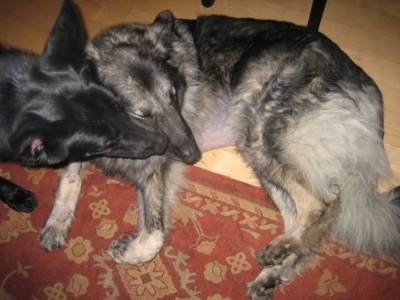
My biggest problem is keeping my 1-year-old Shiloh Shepherd, Shadow off of her. She wants to wrestle, nip and play, but I have to stop it every time. My husband and I have to stay outside with the two of them when we let them out to play or relieve themselves so we can break up the rough-play Shadow instigates every chance she gets.
Friday, 11 days post-op:
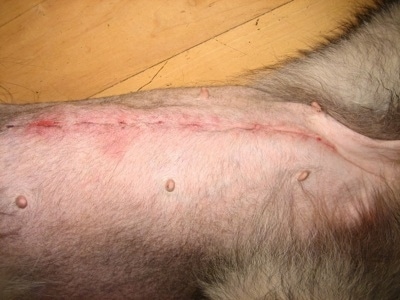
Meadow had her staples removed 11 days after the lifesaving bloat surgery. I have to admit, I think they still look a bit gaping. But, the vet assured me they are fine and look great, "Mother Nature will take care of the rest," he said.
Written by Laurie Maguire © Dog Breed Info Center ® All Rights Reserved










